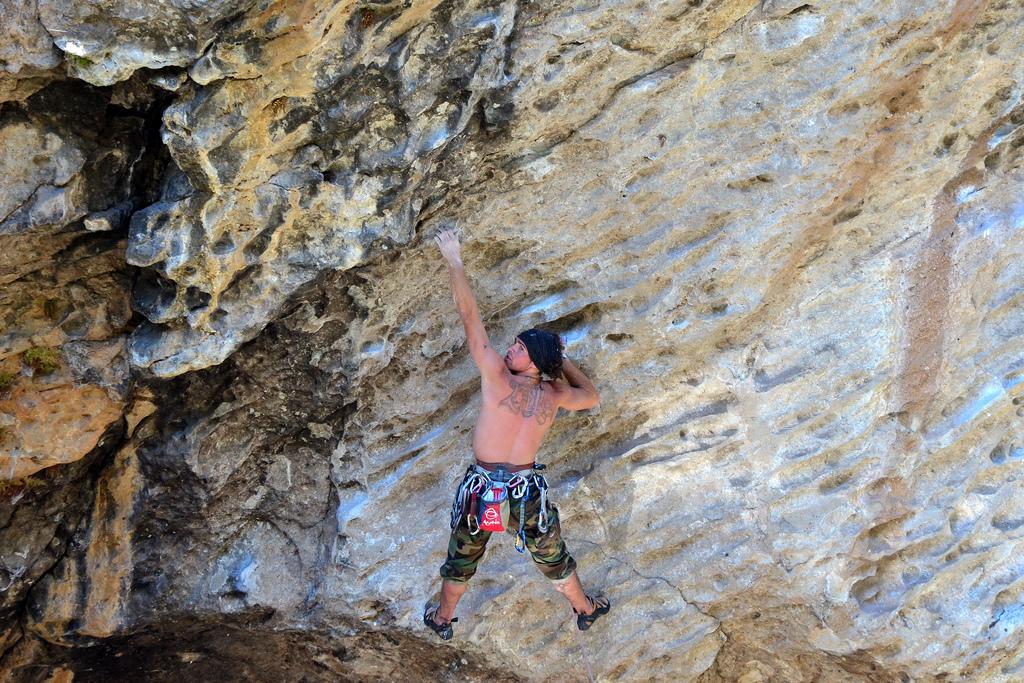How Does Building Muscle Mass Increase Max Strength?
by Paul Chek

I received the following question in response to a recent video I posted on my YouTube channel about an exercise called the Sit-up Stand-up, which is a great calisthenic exercise.
His question is an interesting and very common one about muscle mass versus strength and designing the right program for your specific needs.
ZestyManifesto: Hi! Does increasing your muscle mass, in turn, increase your max strength? I’m quite confused as to if I should be using a circuit format for increased muscle mass and a higher metabolic rate or the station format to improve a specific primal pattern.
I’m a rock climber at the performance level of exercise and I really would like to figure out how to progress past this plateau of not feeling strong enough.

Photo courtesy of Larry Lamsa under Flickr Creative Commons. License.
Muscle mass versus strength
Increasing your muscle mass generally increases maximal strength, but only to a certain point.
This can easily be observed by the fact that even the BIGGEST bodybuilders in the world are not even nearly as strong or powerful as some of the top female Olympic lifters!
There are bodybuilders, for example, who can deadlift over 600 pounds in training, but wouldn’t even come close to winning a powerlifting competition where competitors have a much higher “maximal strength,” particularly relative to body weight.
Here are a couple terms you will benefit from understanding:
 Absolute Strength: This is how strong someone is regardless of their body weight. The people in this class, generally, are your big men who may weigh 300 pounds, and deadlift or squat 1,000 pounds.
Absolute Strength: This is how strong someone is regardless of their body weight. The people in this class, generally, are your big men who may weigh 300 pounds, and deadlift or squat 1,000 pounds.
Relative Strength: How strong someone is and how much they can lift relative to their body weight.
Some examples of high relative strength athletes are rock climbers who can do multiple single-arm chin-ups with “one finger holding the bar!”
Eugen Sandow, the father of bodybuilding and one of the strongest men in the world nearly a century ago, could do astonishing things such as doing backflips while holding onto 35-pound weights in each hand, one-finger pull-ups on stage and breaking chains tightened around his chest.
Sandow weighed 210 pounds and was just under 6 feet tall. (Gymnasts probably have some of the highest relative strength levels of all athletes.)
Here is your complication as a rock climber: If you increase strength along with muscle mass, there comes a tipping point where your strength/power isn’t enough to accommodate the additional weight.
If you gain 20 pounds of muscle using bodybuilding methods, chances are you will be much stronger (absolutely). But, as you increase your muscle mass and body weight, you are likely to find, for instance, that you can’t do single arm chin-ups, and have to go from one finger holds to 3-5 fingers or you “can’t get your body up.”
If you study my Program Design correspondence course, you will learn that strength can be classified in two additional ways:
Metabolic Strength: This is what bodybuilders build the most. Their rep ranges are usually 6-12 (there may be some variations depending on program design skill). Generally, they need to do a lot of work in the 12-rep range to get the volume of training they need to produce lactic acid (do some research on the lactic acid theory of hypertrophy if you’re interested) and get adequate time under tension per set to trigger progressive hypertrophy.
Based on Jerry Telle’s research, eight reps or more is progressively more metabolic in response, which means it is largely changes in the size and internal physiology of the cells that produce hypertrophy and strength gains.
Neural Strength: This occurs with intensities of eight reps or less, and requires progressively more contribution to the lifting effort from “the nervous system.”
This is one of the key loading zones for working with gymnasts, jumping athletes such as dancers and other athletes who have to be cautious of gaining too much body weight. If they do, their relative strength goes down, and they can’t jump or do other explosive activities effectively.
What should a rock climber do to condition effectively?
Rock climbers, like all people, come in a wide variety of sizes and shapes, but the ones who are most naturally suited to the sport are generally lean (bordering on skinny at times) with very high levels of relative strength. They must also have high levels of strength-endurance, meaning they have to be able to perform explosive movements and generate high levels of strength to maintain holds for extended periods of time, such as multiple hours on long, hard climbs.
If budding rock climbers want to improve in their sport but carry a fair bit of body weight (this reduces his/her relative strength or “power to weight ratio”), then they will need to mix circuit training sessions designed with rep ranges and rest periods that facilitate reducing body weight.
In some cases, this could mean a loss of muscle mass as a result of the excess cortisol levels generated by this kind of circuit training.
At some point, a rock climber will have to shift to station training and work in the high-intensity rep ranges of 1-8, and even use negatives of 1-10 reps depending on the experience and conditioning of the athlete.
Sidenote: Negatives mean using a weight you can’t lift because it is too heavy so you can only “lower the load.” An example of negatives used by rock climbers: When they can no longer pull themselves up on a chin-up bar, they will climb up, and then slowly lower themselves, producing a negative rep or eccentric dominant loading.
A powerlifter or Olympic lifter may do negative deadlifts by starting with the bar racked at the height of the top of their deadlift, then lowering the load for a negative rep. This can be done because, on average, people are 30-40 percent stronger eccentrically (lowering the load) than they are concentrically (lifting the load or muscle contraction that results in the shortening of the muscle).
Enhancing your performance
 Since the body can only adapt to a given stimulus for a fixed period of time (influenced by both human physiology and genetic variables from person to person), rock climbers must constantly decide what they need most to enhance performance, so consider these variables.
Since the body can only adapt to a given stimulus for a fixed period of time (influenced by both human physiology and genetic variables from person to person), rock climbers must constantly decide what they need most to enhance performance, so consider these variables.
- If more body mass is needed to increase maximal strength because they’ve maxed out what their neuromuscular system can handle, and more muscle is required to make more maximal strength, be it relative or absolute, rock climbers will have to drop the intensity by increasing the reps per set, often into the bodybuilding range.
- If a rock climber is getting too heavy and losing relative strength, he will have to gain more strength per pound of muscle, which requires neural development. Most people don’t consider the relevance of the strength of the nervous system, or working motor units and “drive factors” that influence the intensity one can generate, or what percentage of their available motor units in any given muscle or muscle group they can recruit.
- If the athlete has adequate relative strength, but lacks strength-endurance, he may resort to circuit training designed to expose him to loads varying from 16-100 reps per set, depending on exactly what his training objective is. High rep sets between 30-100 or more are often used to strengthen tendons, for example, which are important for rock climbers. If he stays in this loading zone too long, he will start adapting to the metabolic demands, and lose adequate time under tension at high intensities to keep the nervous system strong. So, he may be able to climb all day, but doesn’t have the strength or power to make the explosive moves that are often required.
The science of program design
I hope you can see that:
- There is definitely a science to effective program design, and I’ve only skimmed the surface of it all here because it is a significant field of study. This is the very reason I have two DVD programs focusing on program design: Program Design and Advanced Program Design, both of which are available from the C.H.E.K Institute.
- There is a lot that the athlete or coach must know and monitor relative to the specific training objectives at any point in a season or training cycle, or mistakes resulting in diminished performance are likely.
- The athlete has to spend the time to “get to know themselves, their body, and their mind,” and how they respond to given types of training stimulus. Some athletes put on muscle mass very easily and must be very careful in the bodybuilding ranges. Then, there are others who have a very hard time adding muscle mass, so to get to the next level, they will have to use a fair bit of training in bodybuilding ranges. Some will be like wrestlers, who have a very high work capacity, but may be challenged to develop the explosiveness (power) they need.
- Because individual athletes will have very different needs for rest, they won’t all respond well to the same program. Those who have a natural propensity for high performance with neural type training/lifting generally need much more rest between sets and training sessions than those who are naturally built for strength-endurance.
Many athletes lessen their performance by following programs written for teams and groups or designed for a specific individual other than themselves.
If you really want to achieve your potential as an athlete, I’d highly recommend enrolling in CHEK Exercise Coach training. This will give you a holistic, scientific foundation for your own athletic self-development.
Love and chi,
Paul


